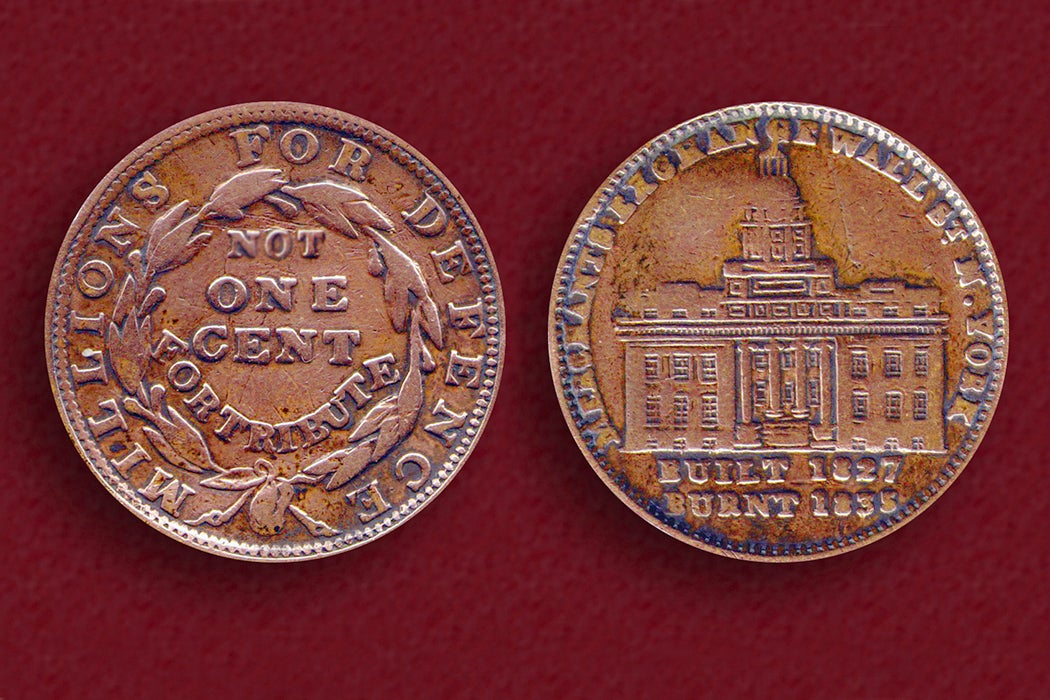If you were in Baltimore, circa 1837, you might have bought your bread with a tiny political cartoon. Small change was hard to come by. In its absence, penny-like coins known as “hard times tokens” circulated widely, a form of unofficial currency.
Hard times tokens seem like normal pennies—until you take a closer look. To avoid charges of counterfeiting, the text on the tokens frequently proclaimed that they were “Not One Cent/But Just As Good.” In the place of the familiar Lincoln’s head, you might notice a ship being wrecked against the rocks, a leaping jackass, or Andrew Jackson popping out of a treasure-chest like a Jack-in-the-Box, encircled by the phrase “I take the responsibility.” These images are succinct expressions of the anger and disappointment felt in the wake of the Panic of 1837 and the economic depression that followed it.
It was a strange moment in the history of money. Most banks were prohibited by the terms of their charters from issuing paper money below a particular value. At the same time, Andrew Jackson’s monetary policies led to a serious shortage of coins. To conduct the transactions of everyday life, people invented their own circulating medium.
Alongside the hard times tokens, a variety of unofficial paper money known as “shinplasters” circulated. The name came from the thin and weak material they were made of, which resembled bandages. Local stores issued their own cheaply-printed shinplasters, and they travelled swiftly through local economies, wherever people would accept them. One contemporary observer recalled seeing a man on the street who carried a whole roll of shinplaster bills tucked into his silk top hat. Whenever he needed to buy something, he would clip off a fresh bill with a pair of scissors.

These alternative currencies raised curious legal questions. In one court case, a man who had stolen a wallet was found not guilty, since the shinplaster notes inside were not technically money. Yet bills from authentic banks could be just as dubious. People were on high alert for money issued by “wild-cat banks”—so called because, supposedly, they were hidden away in remote forests and swamps where only wild cats lived. No one would dare to venture into the wilderness to try and recover the value of the paper money in gold and silver, leaving the wild-cat banks free to operate as they pleased. Some bosses cheated their workers by paying them exclusively in wild-cat notes, which they bought at below face value from “note shavers.”
In a time when wild-cat notes flooded the market, and even legitimate banks had a tendency to fold suddenly, counterfeit notes could be a surer bet than honest ones. In a way, by making more money, counterfeiters were addressing a pressing need, and they were often surprisingly popular. In A Nation of Counterfeiters: Capitalists, Con Men, and the Making of the United States, the historian Stephen Mihm writes:
Though often a nuisance, counterfeiters performed a public service. As one citizen of Michigan observed several decades later, “counterfeiting and issuing worthless ‘bank notes’ . . .was not looked upon as a felony as it would be today. Of course it was taken for granted that it was a ‘little crooked,’ but the scarcity of real money, together with the necessity for a medium of exchange, made almost anything that looked like money answer the purpose.” In a capital-poor region where money remained in short supply… counterfeiters catered to an insatiable demand for credit.
How did it come to this? The story truly begins with the forced expulsion of the Chickasaw, Muscogee, and Choctaw people from their ancestral lands in the South during the 1830s. As the historian Claudio Saunt writes in Financing Dispossession: Stocks, Bonds, and the Deportation of Native Peoples in the Antebellum United States:
The schemes employed… to dispossess the native residents were both banal and appalling. Speculators hired individuals to sell lands that did not belong to them, paying $5 to $10 for each impersonation… They conspired with county sheriffs to seize property for fictional debt. They burned down houses and drove off the residents. In some instances, they held landowners in chains and tortured them until they agreed to sign away their farms. Astonished observers struggled to find words to describe the situation… The victims spoke more personally about the violence. “We have for the last six months lived in fire,” said Neah Micco. A resident of Hachachubbe, in northern Alabama, explained with “great bitterness” that his land had been stolen. Yet, he continued, “he would stay and die here and then the whites might have his skull for a water cup,” a reference to the phrenologist who had recently raided burial sites in his town and carried off a number of crania.
As agents cleared the way for plantation-style cotton production on the lands that once belonged to native peoples through a combination of violence, extortion, and deception, a vast bubble of speculation began to swell, and land prices rose to dizzying heights. In 1836, Andrew Jackson attempted to pop the land speculation bubble by mandating that all purchases of federal lands be made with gold and silver, not paper money.
Weekly Newsletter
But as the economist Peter L. Rousseau argues in Jacksonian Monetary Policy, Specie Flows, and the Panic of 1837, this attempt failed. Prices continued to rise, and speculators cleared out the gold and silver reserves held by New York banks in a rush to buy Southern land. As merchants caught on to the depletion of specie reserves, they panicked, triggering a run on the banks. The banks countered by suspending specie payments, and taking a good proportion of coins out of circulation, in turn making way for shinplasters and hard times tokens.
Support JSTOR Daily! Join our new membership program on Patreon today.







